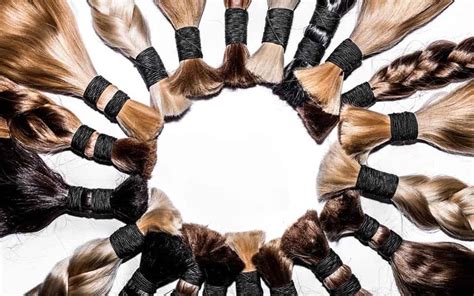Table of Contents:
- Introduction
- Benefits and Drawbacks of Glue-In Extensions
- Choosing the Right Extensions and Glue
- Step-by-Step Guide to Applying Glue-In Extensions
- Maintenance and Removal of Glue-In Extensions
- Troubleshooting Common Issues
- Creative Applications for Glue-In Extensions
- Comparison of Glue-In Extensions with Other Methods
- Conclusion
Introduction
Glue-in extensions are a popular hair extension method that allows you to add length, volume, and color to your natural hair without damaging it. They are versatile, durable, and can last for several months with proper care. This guide will provide you with comprehensive information about glue-in extensions, including their benefits and drawbacks, how to choose the right extensions and glue, a step-by-step application guide, and troubleshooting tips.

Benefits and Drawbacks of Glue-In Extensions
Benefits:
- Long-lasting: Glue-in extensions can last for 4-8 weeks with proper care.
- Versatile: They can be used to add length, volume, and color to your hair, and can be styled in various ways.
- Durable: Glue-in extensions are less prone to tangling and breakage than other extension methods.
- No heat damage: They are applied without the use of heat, which eliminates the risk of damaging your natural hair.
Drawbacks:
- Potential for scalp irritation and allergic reactions: Some types of glue can irritate the scalp or cause allergic reactions.
- Can be difficult to remove: Glue-in extensions require a professional to remove them properly to avoid damaging your natural hair.
- Can be expensive: Glue-in extensions can be more expensive than other extension methods.
Choosing the Right Extensions and Glue
Choosing the right extensions and glue is essential to ensure a successful application.
Extensions:
- Texture: Choose extensions that match the texture of your natural hair for a seamless blend.
- Color: Select extensions that are closest to your natural hair color or consider adding highlights or lowlights for a more natural look.
- Length and Volume: Determine the desired length and volume of your extensions based on your personal preferences and hair type.
Glue:
- Type: There are two main types of glue used for glue-in extensions: keratins, which are a type of protein, and polymers, which are synthetic.
- Quality: Choose high-quality glue that is specifically designed for hair extensions. Avoid using household adhesives or quick-drying glues.
Step-by-Step Guide to Applying Glue-In Extensions
Materials:
- Glue-in extensions
- Hair glue
- Sectioning clips
- Rattail comb
- Heat gun or blow dryer
Step 1: Prepare Your Hair
- Wash and blow dry your hair.
- Section off the top layer of your hair and secure it with a clip.
Step 2: Apply the Glue
- Dip the base of an extension into the hair glue.
- Apply a thin layer of glue to the base of your natural hair, about 1/4 inch from the scalp.
Step 3: Position the Extension
- Align the extension with the base of your natural hair.
- Press the extension firmly into place and hold it for a few seconds to allow the glue to set.
Step 4: Repeat the Process
- Continue applying extensions row by row, working your way up the sectioned area.
Step 5: Heat the Glue
- Once all the extensions are in place, use a heat gun or blow dryer on low heat to activate the glue and create a strong bond.
Step 6: Blend the Extensions
- Use a rattail comb to gently blend the extensions with your natural hair.
- Style your hair as desired.
Maintenance and Removal of Glue-In Extensions
Maintenance:
- Brush your extensions gently to avoid tangling.
- Avoid washing your hair too often.
- Use sulfate-free shampoo and conditioner.
- Avoid using heat styling tools directly on the extensions.
Removal:
- Professional removal is recommended to avoid damaging your natural hair.
- The stylist will use a special glue remover to dissolve the bond between the extensions and your hair.
Troubleshooting Common Issues
- Scalp irritation: Switch to a different type of glue or consider consulting with a dermatologist.
- Extensions slipping out: Inspect the glue for any gaps or weaknesses. Reapply glue as needed.
- Extensions tangling: Brush your extensions gently and avoid using excessive hairspray or styling products.
- Hair breakage: Avoid pulling on the extensions or sleeping with your hair wet.
Creative Applications for Glue-In Extensions
Beyond their traditional uses, glue-in extensions can be used in creative ways to achieve unique hair transformations.
- Color Blocking: Use extensions in different colors to create bold, geometric patterns.
- Ombré and Balayage: Create seamless ombré or balayage looks by blending extensions of different shades.
- Texture Mixing: Combine different textures of extensions, such as straight and curly, to add volume and interest to your hair.
- Undercut Designs: Use extensions to cover undercut designs and create a unique and edgy look.
Comparison of Glue-In Extensions with Other Methods
| Method | Duration | Damage | Cost | Versatility |
|---|---|---|---|---|
| Glue-In Extensions | 4-8 weeks | Low | Moderate | High |
| Clip-In Extensions | 1-2 days | None | Low | Medium |
| Tape-In Extensions | 6-8 weeks | Low | Moderate | Medium |
| Sew-In Extensions | 6-12 weeks | Medium | High | Low |
| Weave Extensions | 2-4 months | Medium | High | Medium |
Conclusion
Glue-in extensions offer a long-lasting and versatile solution for hair transformations. By following the proper application and maintenance techniques, you can achieve stunning results and enjoy your extensions for several months. With their ability to add length, volume, and color, glue-in extensions empower you to experiment with your hair and create a look that is uniquely yours.
